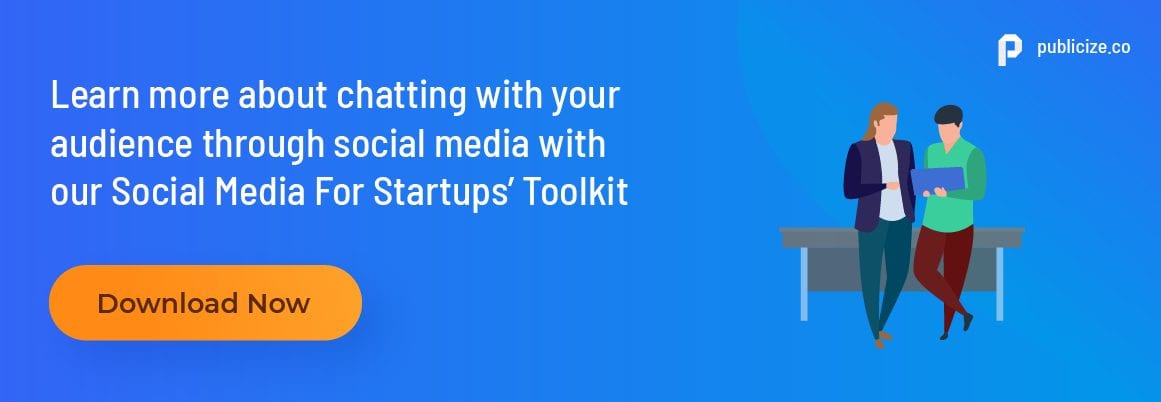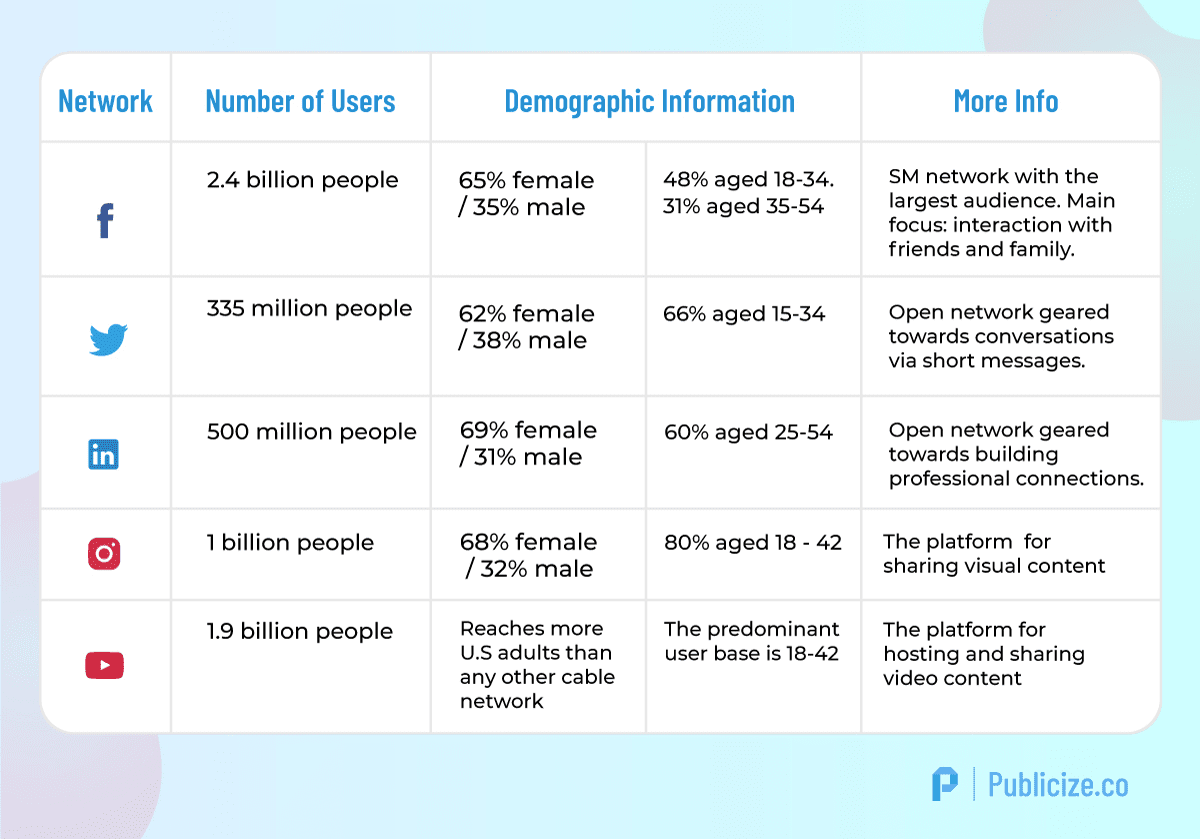If you thought social media was just for looking at cat videos, sending regretful messages at 3 am, or procrastinating once it hits 4 pm – you’re so wrong.
Speaking from a marketing and PR perspective, social media can be an invaluable weapon for your startup’s prosperity and growth. Furthermore, unlike other forms of marketing and PR, social media allows you to interact far more directly with your audience.
With that in mind, we’ve put together this guide to help you combine social media and PR. It includes:
- Why use social media?
- What is social media PR?
- What is the difference between social media marketing and social media PR?
- How social media has changed PR
- How to use social media for public relations
- Which social media channel is best to reach your PR goals
Why use social media?
Social media provides a seamless ability to share photos, opinions, events, etc., all in real-time. This has revolutionized the way we interact in our personal and professional lives.
Not convinced of social media’s impact?
Well, consider this mind-boggling statistic. 77% of North Americans own at least one social media profile.
Furthermore, the widespread usage of social media is only going to increase. The ‘customers of tomorrow’ (or millennials) use social media the most. In fact, 90% of teenagers access social media at least once a day.
If the increased exposure to a previously untapped audience isn’t enough of an incentive for you to use social media marketing and PR, then also consider these benefits:
- Faster and Easier Communication – this is great for both you and your customers. Customers can reach you easier than ever before and you’ll be able to receive, review and respond to customers faster and easier than ever before.
- Boosts Organic Visibility – Social media is also great for SEO. Not only does it get more eyes on your business – which helps you rise up Google’s rankings – it also sends relevancy signals to Google to ensure that popular content is easy to share.
- Increase In Website Traffic – Social media’s ability to reach different audiences in a fun and personal way can lead to an increase in site users (if done correctly)
- Branding – The impression your business gives off and the reputation it builds can be greatly enhanced and showcased through social media.
Considering these factors, it would be a PR own goal if your startup didn’t incorporate social media into your PR and marketing strategy. So if you’re not already using social media for pr and marketing, now is high time to start doing so.
Social media PR
What is social media PR?
Social media PR, or also referred to as social PR, can be a weird concept for most people to get their heads around…
- Where is the media gatekeeper?
- Where are the messages broadcasted?
There aren’t the traditional earned media wins there are with most PR. That’s true. However, there are likes, retweets, comments, and – most importantly – shared content.
Social media public relations is not about creating news.
It’s about planting the seed and then trying to help it grow through natural, organic, and personal referrals.
What is the difference between social media marketing and social media PR?
Social media marketing and social PR complement each other when bringing brand awareness, but what pulls them apart?
Even though the lines are often blurred, social media marketing focuses more on direct sales and conversions, whereas social media PR places more emphasis on building a positive brand image, networking with media influencers and building brand trust with a target audience.
The question, however, is not about which one is better. It’s about how to best leverage both to amplify your company’s growth.
How social media has changed PR?
The impact of social media on public relations has been significant. As a PR channel, it fosters an informal yet powerful style of messaging that forms a brand’s true ‘voice’, and revolutionized the way businesses communicate with their audiences.
Likewise, social media has become pivotal when addressing PR crises, allowing businesses to immediately address shareholders in moments of adversity.. This has driven PR towards a more customer focused approach. When before earning publicity was the main measure of success, now there are new important metrics to be considered as well, such as audience engagement.
Social media has made it easier than ever before for people to voice their opinions and alter someone else’s perception – often in less than 140 characters. As a result, suspicion and distrust towards businesses has increased. 72% of people believe CEOs are less trustworthy than their employees. PR is designed to fight this distrust.
Additionally, competition for tech startups is at an all-time high. Whether you’re in fintech, SaaS, or blockchain, tech markets are now oversaturated with fresh-faced startups with new innovations and the desire to make big bucks. As a result, 90% of startups end in failure.
Ignore social media PR at your peril!

How to use social media for public relations
OK, now you need a game plan.
As we touched on, social media and public relations is not as well signposted as other strands of PR, such as digital PR or tech PR.
Fear not, here are some social media PR tactics you can start using straight away:
Find influencers within your niche
Consumer trust is at an all-time low. Considering the current climate, it’s surprising that consumer trust in social media influencers is on the up. With as many as 49% of consumers depending on influencer recommendations.
First off, let me define what an influencer is.
An influencer is an individual who has the power to affect purchase decisions because of his/her knowledge, authority position or relationship with their audience. These tastemakers are not just your run of the mill celebrity. They could also be:
- YouTube vloggers
- Instagram models
- Facebook ‘top fans’
- Twitter influencers
- CEO’s or business owners who have a large LinkedIn following
Now let’s quickly clear up a common misconception. Influencer marketing more often than not falls under the umbrella of paid media. This is different to earned media, which is the end goal of PR.
What’s paid media?
Paid media is any form of advertising which is paid for directly. Therefore, when a company pays an influencer to plug their product, this is advertising via social media, rather than social media and public relations.
So while the bulk of influencer endorsements isn’t strictly social media public relations, interacting with social media influencers still serves a PR purpose.
Networking and building relationships with relevant influencers can gain you valuable shared media wins. For example, you could gain retweets and shares of your content or even a guest posting spot on an influencer’s websites at no cost.
Network with journalists
Social media can be invaluable when you’re looking to build relationships with different journalists. If you’re going to pitch to journalists before establishing any kind of relationship with them, you’ll often be knocked back.
However, using social media you can follow journalists from relevant industries and share and praise their work. This is something that’s only been made possible due to social media.
If you’re going down this route, remember to be polite and keep it personal. However, don’t start randomly liking their photos. That’s just straight-up creepy.
React to negative press
PR has long been a useful tool for companies needing to manage media backlash. In PR circles, this is referred to as ‘crisis management’. This is where PR professionals use their expertise and contacts within the press to quash negative coverage.
Yes, if you’re a fresh-faced new startup, it’s unlikely you’ve received much press – let alone experienced the media sharpening and aiming their pitchforks at you.
However, if this does happen, pr and social media gives you the opportunity to put out the fire yourself.
Previously, you would have had to send out a press release or write leaders to newspaper editors responding to the accusations. Now, social media allows you to share an official statement, blog post or press release across your channels.
Respond and communicate to your target audience in real-time
Social media’s instant communication allows you to respond to your target audience in real-time.
This is great for a few things:
- Forming relationships
- Showing your business’s human side
- Replying and dealing with complaints or negative comments
This two-way communication between you and your customers was previously limited. Therefore, this is rather revolutionary from a PR perspective.
Furthermore, it’s more evidence of the lines between PR, marketing and customer service becoming increasingly blurred due to social media.
PRO TIP: The speed of your response rate is very important. On Facebook, 85% of North American consumers expect a reply within six hours. This can be difficult if you don’t have a dedicated social media manager. We’d recommend you look into automated replies or a chatbot. This will buy you some time before replying personally
Make company announcements
Social media allows you to share your company announcements and news to your followers. Furthermore, if this is shared multiple times, your reach is even larger than that.
This is partially why some people believe that press releases are becoming obsolete.
While we don’t share that sentiment, we definitely believe that social media can be used alongside press releases in order to broadcast your news or events to more people.
Social media also allows you to invite people to events or conferences you are hosting or attending, too.

Which social media channel is best for your PR needs?
OK, so now you’ve seen some of the ways you can integrate social media into your PR efforts, we’re taking a deeper look at the 5 different social media channels:

Each social media platform can be used in its own unique way to assist in PR.
Here are some examples of how each of these channels can be used to add value to your PR plan:
- Facebook – Facebook is the perfect vessel for brands and companies to strike up conversations with their target audiences. Leverage Facebook functions such as groups, mentions, call to action buttons and other professional services tools to assist with using Facebook for PR activities.
- Twitter – With its 140-character limit, it’s the best way to send a quick message about a new launch, activity, or promotion, or to provide any kind of update. Using hashtags is a great way to reach people and also to track what your audience and others are saying about your company or brand. Twitter has various ways to conduct research on your company, brand, competitor, and more. In addition, its app, Periscope, is a great way to live stream and connect with an audience.
- LinkedIn – This is another great way to connect with people, especially influencers, gain industry insight and circulate relevant information. It is also a great tool to utilize for blogging.
- Instagram – This platform is a great way to engage with your audience. Visuals are excellent for showcasing worthy causes and bringing awareness to serious issues. In addition, Instagram is great for promoting events (before, during and after) to keep the audience engaged and feeling as if they are a part of the event, even if they are not.
- YouTube – Videos are on the rise. Furthermore, when looking to learn about a subject, millennials frequently turn to ‘how-to videos’ with text on them. Therefore, if you have a lot of difficult to grasp concepts or are in an industry that people find hard to get their head around (e.g. Blockchain) YouTube may be a great social channel to focus your PR efforts towards.
After reading this, you’ll probably have a clearer vision of the social media channel best-suited to your PR strategy.
However, whichever one you think is the most aligned with your target audience, you should still aim to incorporate all of them as part of your marketing and PR strategy.

Wrapping up…
Social media is no longer an option for your PR efforts — it’s an imperative.
With this in mind, we’d recommend that you consider some of the tips and social media PR tactics we’ve included in this social media PR guide and choose the channels that are best aligned with your target audience.
In our experience, a lot of companies neglect rather than invest in their social media. To them, it’s an afterthought, a nice bolt-on, and hardly informative of their marketing efforts’ success. We’re sad to say that they’re missing a trick. Fortunately for you, you won’t make that same mistake.
By making use of social media PR and refining your brand’s communications to your target audience, you can build your company’s reputation from an unknown entity into a thought-leading industry trailblazer with a few carefully crafted posts.





